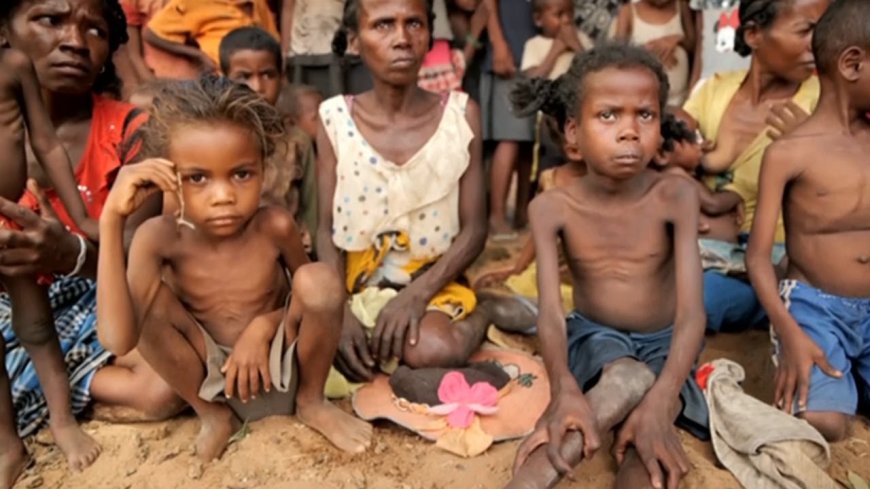Southern Madagascar’s Hidden Hunger Crisis: A Nation Fades While the World Looks Away
A silent hunger crisis is gripping southern Madagascar due to climate-induced drought. Children are collapsing in schools, and food insecurity is escalating.

An Urgent Crisis Unfolds Beyond the Headlines
While most global media remain fixated on political summits and economic forecasts, an unfolding humanitarian catastrophe in southern Madagascar is quietly devastating thousands of lives. A prolonged drought, driven by a lethal mix of climate change, poverty, and inadequate infrastructure, is plunging entire communities into extreme food insecurity.
Reports from on-ground humanitarian agencies describe a grim scene: children fainting in classrooms, families surviving on cactus leaves, and once-fertile fields reduced to dry, cracked earth.
“We’ve seen 8-year-olds collapse from hunger,” said Lanto Raveloson, a teacher from Androy district. “There’s no food, and water is hours away.”
This situation, often referred to as a “climate-induced famine,” is worsening rapidly—yet remains woefully underreported.
Why Southern Madagascar Is Suffering
Southern Madagascar, especially the Androy, Anosy, and Atsimo-Andrefana regions, has been facing recurrent droughts for more than a decade. But the current dry spell—now in its fourth consecutive year—is described as one of the worst in recent memory.
Key Causes:
-
Climate change: Erratic rainfall patterns and desertification have turned once-arable land barren.
-
Dependence on subsistence farming: Over 80% of rural Malagasy families depend on rain-fed agriculture.
-
Infrastructure gaps: Lack of roads and irrigation prevents aid delivery and sustainable farming.
-
Neglected policymaking: Successive governments have underfunded long-term food resilience programs in the south.
According to the UN World Food Programme (WFP), over 1.2 million people are currently food insecure, with more than 14,000 classified in “catastrophic” famine-level conditions (IPC Phase 5).
Human Toll: “My Son Went Three Days Without Eating”
The tragedy is not abstract. In villages like Ambovombe, mothers are feeding children boiled tamarind leaves and cactus pods. These are not traditional foods, but last-resort survival fare.
Fatima, a 34-year-old mother of three, recounted, “My son went three days without eating before we got half a cup of rice from the aid truck. I had to decide which child to feed first.”
Local schools are now emergency nutrition centers, distributing porridge and vitamin supplements. Yet, teachers report declining attendance because hungry children can’t walk the distances to school.
Aid Is Arriving—But Not Enough
International organizations like UNICEF, WFP, and Médecins Sans Frontières (Doctors Without Borders) have intensified efforts. Mobile medical clinics are treating malnutrition-induced anemia, while nutrition kits are being delivered to priority zones.
But the logistical challenges are severe:
-
Roads are nearly impassable during the dry season.
-
Rising global food prices are shrinking aid budgets.
-
Less than 60% of the required humanitarian funding for southern Madagascar has been met in 2025.
“The world must act now. This is not a drought we can wait out. Children are dying,” said David Beasley, former Executive Director of WFP, in a recent policy roundtable.
Long-Term Consequences: A Generation at Risk
If the situation continues, experts warn of a “lost generation” in southern Madagascar. Malnutrition not only causes stunting and physical weakness but also impairs cognitive development, threatening the future productivity of entire communities.
Additionally, migration pressures are rising as families abandon ancestral homes to search for food and water elsewhere. This is already straining cities like Tuléar and Fort Dauphin, where urban poverty is swelling.
Without systemic intervention—reliable irrigation, food storage facilities, and diversified income streams—the cycle of crisis will repeat.
What Can Be Done?
1. Immediate Solutions
-
Scale up emergency aid to meet the 2025 UN humanitarian funding target.
-
Improve logistics using local partnerships for last-mile delivery.
-
Distribute drought-resistant seeds to farmers in preparation for the next planting season.
2. Long-Term Interventions
-
Invest in climate-resilient agriculture like drip irrigation and permaculture.
-
Develop rural infrastructure including roads, water pipelines, and grain banks.
-
Encourage international cooperation through debt relief and green development funding.
Why the World Should Pay Attention
The Madagascar famine is a climate warning shot. Unlike conflict-driven famines, this crisis stems almost entirely from environmental collapse—making it a harbinger for other vulnerable nations in sub-Saharan Africa and Asia.
This disaster reminds us that climate change doesn’t only manifest in floods and heatwaves—it silently starves. If we ignore southern Madagascar today, similar crises may arise in Chad, Yemen, or Rajasthan tomorrow.














